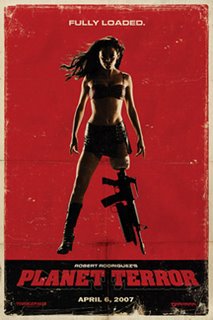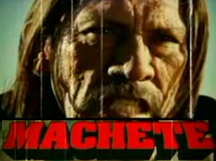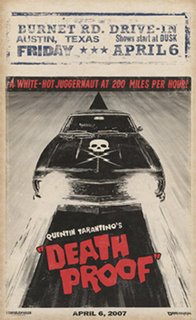Double Feature Picture Show!
Make no mistake... I went into Grindhouse expecting it to be the greatest film ever made. Yeah, I know that's a pretty ridiculous expectation for any adult to have (heck, ask any Star Wars fan), but I couldn't help it. I was giddy with anticipation and could hardly bring myself to wait a single day after its premiere so that my wife could go with me. (Somehow I managed, but those 24 hours were excruciating.) Honestly, there was no way that ANY movie could have lived up to the expectations that I had for this one. I mean... this movie was made FOR me... or people like me, anyway. So, it had to be the greatest spectacle to ever hit the screens, right? Well, as I surely suspected in the deepest recesses of my brain, it wasn't. But I'll be damned if it didn't come real close.
As I'm sure you know, Grindhouse is not so much a movie as it is two separate and distinct movies presented in a "double feature" format. So for ease of reading and writing I will review the two films as separate .
 Planet Terror
Planet Terror(2007)
The other day I was at my parents house, and my dad was watching Sin City on cable. I asked if he'd seen the trailers for Grindhouse, and he asked, "Oh, you mean that movie with the girl who has a machine gun for a leg?" That little scenario proves that if Robert Rodriguez learned nothing else from the masters of exploitation cinema, he sure learned the most important rule: Give the audience something to remember. Even if Grindhouse fails miserably at the box office and is shuffled off to the bottoms of $5 dvd bins around the country, you can rest assured that twenty years down the line people our age are gonna remember "the movie where the girl had a machine gun for a leg." It's the kinda thing that catapults an already good chunk of storytelling to the sublime.
Rodriguez offers up a pretty straightforward zombie apocalypse story, but deftly weaves so many interesting story arcs throughout the chaos that you are absolutely riveted from the first tattered frame to the last. Dakota Block is a doctor and the wife of a doctor looking to escape from beneath the domineering hand of her husband. El Wray is the local misfit looking to rekindle an affair with unipedal go-go dancer Cherry Darling. The local police are as clueless as they are bumbling and must unite with the town's rag-tag crew of survivors to take on the shadowy military agency responsible for the viral outbreak.
One of the film's major strengths lies in its character actor-populated ensemble cast. Just like in the classic exploitation films, you'll find no bona fide movie stars here. At least not in leading roles. Planet Terror is a bizarro world in which Bruce Willis is relegated to the sidelines to give more face time to genre stalwarts such as Jeff Fahey, Michale Biehn and (cue heavenly choirs) Tom Savini. Rose McGowan is pitch perfect as the stoic non-victim Cherry Darling and successfully cements her position as the Reese Witherspoon for the horror set.
It's impossible to talk about Grindhouse without addressing the lengths the filmmakers went to in order to make the films look like authentic artifacts from years gone by. While every second of the entire "double feature" was created to evoke the feel of vintage exploitation cinema, it's obvious that Rodriguez took the most care in preserving the "grindhouse experience." With all the grit and grime of a war-torn print that's travelled movie houses from coast to coast, Planet Terror certainly has the look and retro-cool visuals to spare, but it's the music that makes this feature seem so legit.
Taking cues from John Carpenter, Rodriguez composed the sparse, pulsating score for the film and in doing so succeeded in giving the film more of a retro feel than any amount of faux dust n' scratches could have. The primary theme, a bluesy guitar and sax piece, is revisited throughout the film in a series of synth riffs remeniscent of the Goblin score for Dawn of the Dead.
As the horror genre continues in its current "retrospective" phase, it's nice to see filmmakers who choose to pay homage to the past with an original and innovative vision instead of bland "remakes." I'd much rather see a quick, wink-wink nod to Fulci than an unnecessary update of one of his films, and that's exactly the kind of thing that Rodriguez excels at. He's a cinematic remix artist, mining the depths of forgotten celluloid and making something fresh, cool and new.
Coming Attractions:
As you are probably well aware, one of the more novel concepts that serves to round out the whole "double feature eperience" was the inclusions of trailers for imaginary exploitation titles. It's no secret that the majority of these exploitation films failed to top the trailers that advertised them. In truth, the trailers most often contained all of the best bits from the film, in hopes of getting as many butts in the seats as possible. So, basically in a grindhouse trailer you got a condensed, easily digestible version of the film itself. It's amazing how ahead of their times those filmmakers were.
 Machete
Machete
 Machete
MacheteDanny Trejo's spectacularly craggy face takes center stage in a trailer that kicks off the ride that is Grindhouse. It's a revenge story about one bad Mexican taking on a group of suited baddies who've duped him into a faux assassination attempt. With assistance from a heavily armed priest, the pair take on "the man" with more intensity than any blaxploitation anti-hero you can imagine. Rodriguez gives us a brand spanking new subgenre of exploitation cinema. Call it, Mexploitation! Oh yeah, I dunno what happened, but the word going into this film was that there were three trailers directed by guest directors and one each from Tarantino and Rodriguez. Obviously we got Machete, but was where was QT's sexploitation trailer, Cowgirls in Sweden? What gives!?!?
Werewolf Women of the S.S.
Rob Zombie takes on the most taboo subgenre of exploitation cinema, nazisploitation. I particularly love how the trailer keeps coming back to the same clip again and again to punctuate the title. You just know that if this film really existed, that would be the only scene with a werewolf int he entire film! I don't know how many times I've seen that kinda thing in real trailers from the era.
Don't
Edgar Wright rocks the kind of trailer that films with few shocking images to entice an audience have to go with. We're talking about 80% style and 20% substance. Sure you get little snippets of story, but in the end... it's all about raising questions that only viewing the film can answer.
Eli Roth rounds out the coming attractions right with a season-specific slasher flick in the grand tradition of the 80s classicks My Bloody Valentine and Silent Night, Deadly Night. As far as the trailers go, it's obvious that the film makers saved the best for last. I mean, how did this film not get made.
 Death Proof
Death Proof(2007)
The name Quentin Tarantino calls to mind such certain expectations that it is nearly a film genre unto itself. Explicit violence, "deep cuts" from forgotten albums and copious amounts of pop-culture-peppered dialogue are the hallmarks of his films and, believe me, in Death Proof you get plenty of all that. The only problem is that you get it in the wrong ratio. The classic exploitation films were cinema boiled down to their most basic components. They were immediate and visceral and were crafted by workhorse directors who understood that if you want to keep your audience, you have to keep the action coming.
In interviews about Grindhouse the directing team expressed a desire to create exploitation films that actually made good on all of their trailers' impossible promises, but I think the two directors came at their projects from different angles. Rodriguez created the ultimate exploitation film: unabashedly over the top. Tarantino, it seems, wanted to beef-up a classic exploitation-type flick and turn it into a full-fledged film. He wanted to keep the moral ambiguity, the brutality, the sleazy swagger and add in all those "real movie" things that the typical grindhouse fare lacked: well written dialogue, character development, you know... basic storytelling-type stuff. The only problem is that stuff simply doesn't belong in exploitation cinema.
Remember, for every classic exploitation title you've heard of there are probably fifty more that don't even exist any more in any form. That's a lot of trial and error. In the handful of grindhouse "success stories," though, dialogue and character development are never major strong points. People come into these types of films with a certain set of expectations, and sitting through scene after scene of people talking is not on the list. For the first twenty-odd minutes of Death Proof, that's exactly what you get. Girls driving around Austin, talking. Girls sitting in a taco joint, talking. Girls at a bar, listening to T. Rex and talking. And their conversations, for the most part, have nothing to do with the story. I understand the idea of establishing a backstory for your characters, but when your audience has come out to see a film that's actually called Grindhouse, you can't let them go that long listening to the idle chatter of three abravise young ladies without tossing in a little violence or nudity to snap them back into the story. It's just against the rules. Now, I don't do spoiler warnings, so if you're a big baby, go ahead and ignore the next sentence or two. The fact that Death Proof spends an entire half of the movie introducing characters that are killed off is a travesty. Any grindhouse director worth his salt would surely agree that character development for murder victims is a waste of time and, more importantly, money.
The second half of the movie involves the villain, Kurt Russell as Stuntman Mike, tracking down a new set of babes to vehicularly assassinate. Unfortunately for him, the crew he's set his eyes on includes a couple of no nonsense Hollywood stuntbabes. Obviously, this group isn't going to put up with his antics lying down. These girls represent the amazonian godesses that doled out many a much deserved ass thumpin in 70s exploitation films. They are so obviously destined to give Stuntman Mike his comeuppance that you actually want to know a little something about their background. Sure you get little snippets of backstory here and there, but what you actually glean is just this side of nothing. It's ironic. The first group of girls... their function in the story was essentially that of a plot-advancing device, and we knew everything about them. This group essentially represents the collective hero of the piece, and we get next to nothing. I would have felt better about it if we would have gotten too much info on both groups, or no info on either group, but as it is in the film it just seems backwards and wrong.
Don't get me wrong. Death Proof does not ruin Grindhouse as a total film experience. In fact, there is much in it that could warrant a full ticket price as a standalone movie. Kurt Russell turns in a great performance playing a disgruntled relic from the grindhouse heyday. He's not so much a monster as he is a charming "regular guy" who just happens to enjoy offing young ladies with his flat black Chevy Nova. The stunts have all obviously been performed live for the camera and at times they had me squirming in my seat. And the two major kill scenes... one is so abrupt that, even though you know it's inevitable, it still takes you by surprise and leaves you feeling a bit hollow. The other is presented like a horrifying, slow-mo ballet that you'd look away from if it weren't so sickeningly captivating.
I truly appreciate what Tarantino was trying to do with Death Proof. I don't know how many times I've fantasized about taking an obscure film and making it into a "real" movie (keep an eye out for my sleazy-cool take on Beat Girl coming out sometime around two thousand and never!). But as a filmmaker with a true love of all cinema and a special place in his heart for exploitation films, I would have expected him to understand the fundamentals of the genre he was attempting to pay homage to. Instead, he allowed a love of hearing his own voice (I mean, a "hot chick" referencing Zatoichi? C'mon!) to make what could have been a mindblowingly wild ride into what was at its highest point an okay film and at lowest, the very definition of tedium.
If you haven't seen it one of the other hundred times I've posted it on the blog, you can find the Grindhouse trailer here.
Labels: theater
posted by Steve at
7:15 PM
![]()
![]()


0 Comments:
Post a Comment
Subscribe to Post Comments [Atom]
<< Home